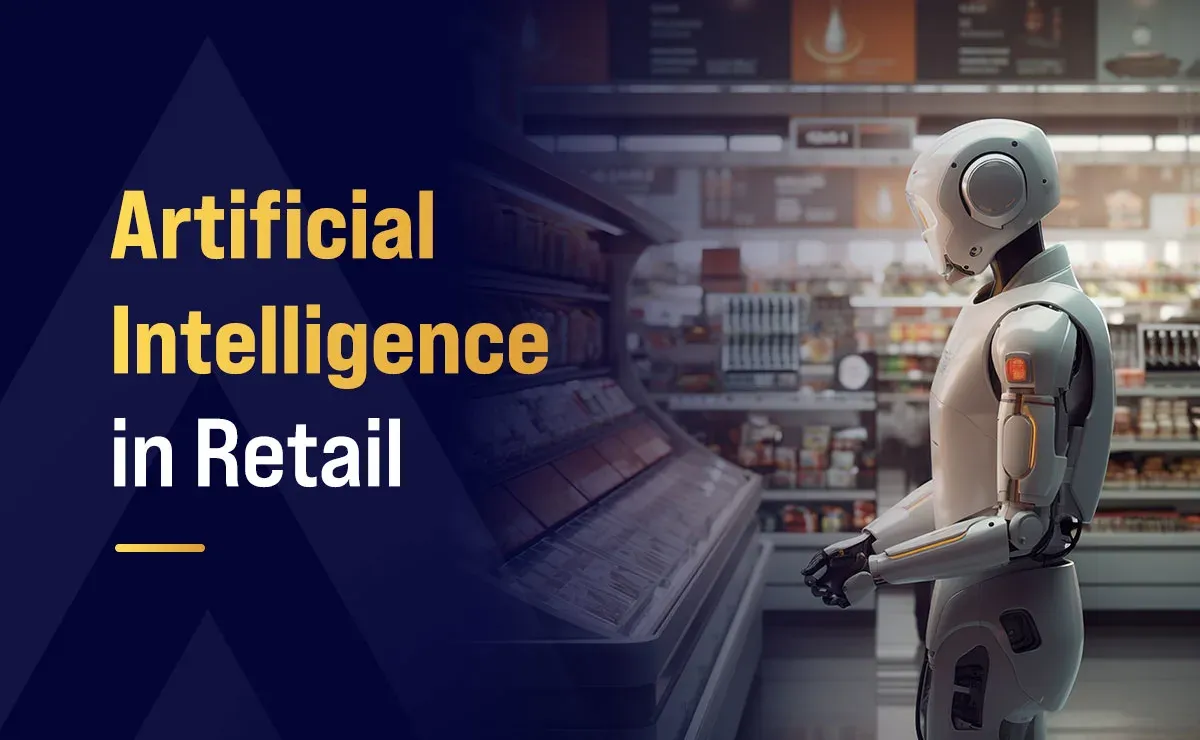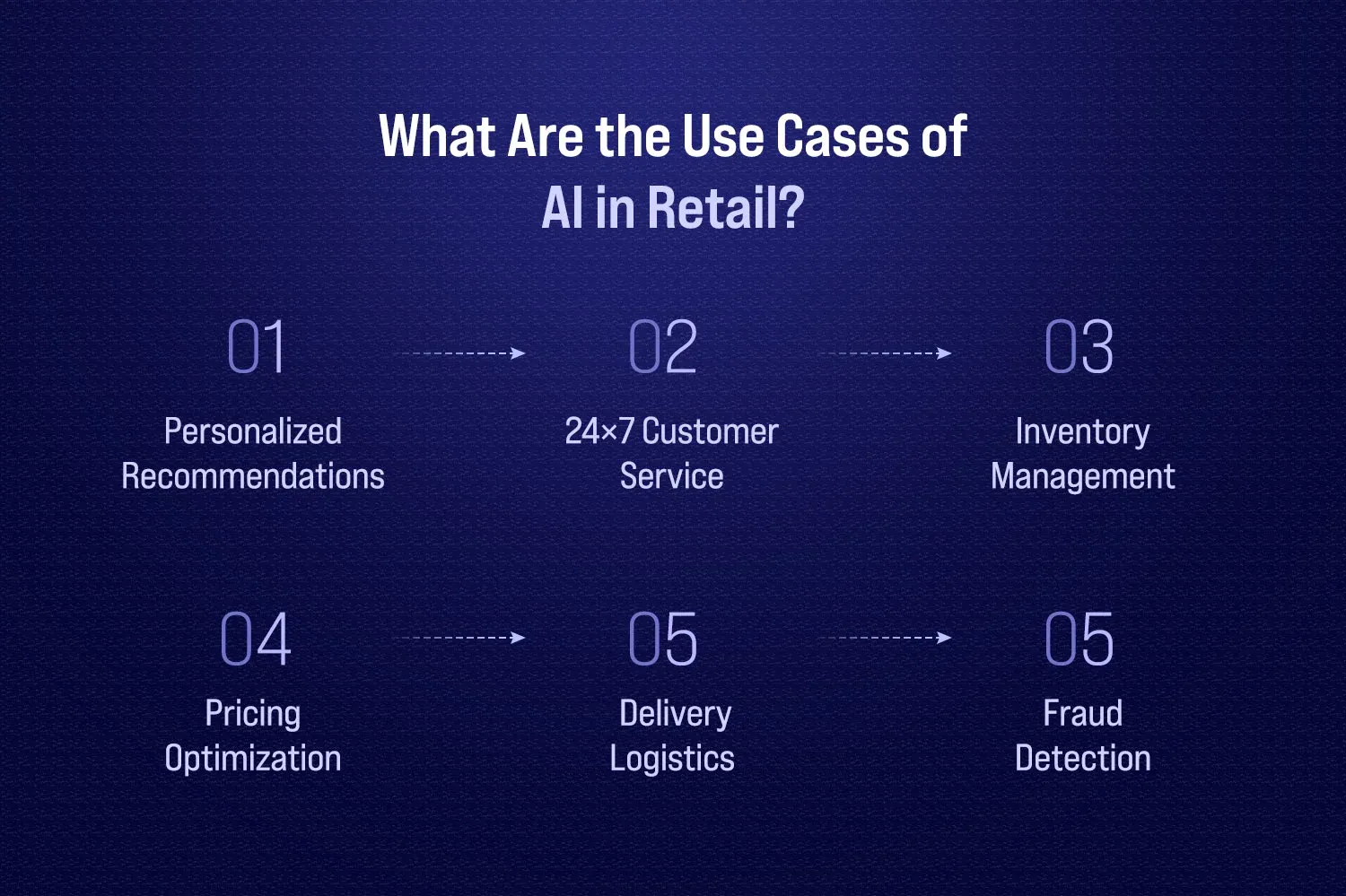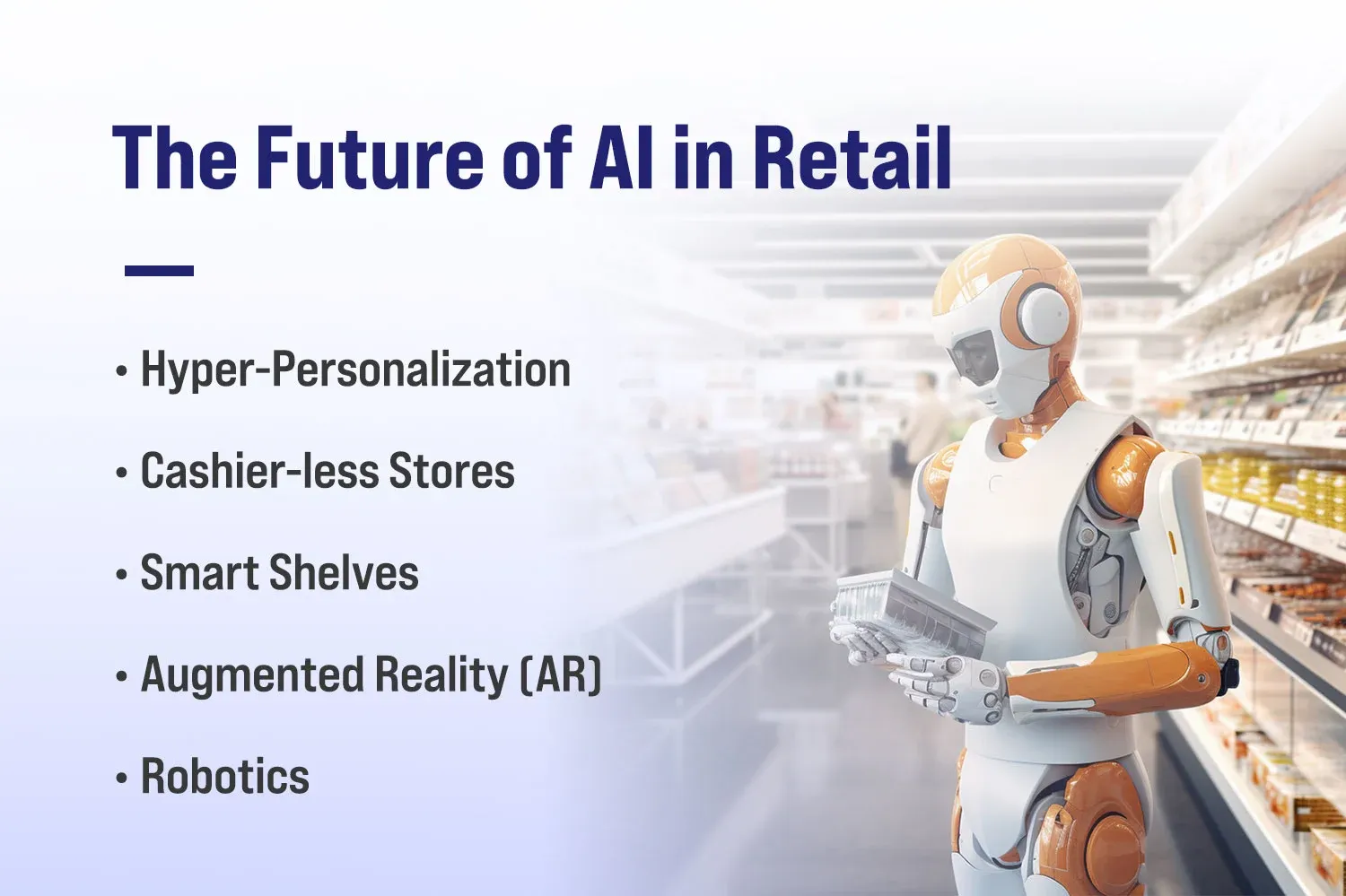Artificial Intelligence in Retail

The retail industry has experienced a significant shift toward digital innovation in the past ten years. Fueled by mobile channels, eCommerce, and omnichannel integration, modern retailers must meet ever-rising consumer expectations for personalization, speed, and convenience.
Driving this change are two game-changing technologies: the Internet of Things (IoT) and artificial intelligence (AI). Together, they turn vast streams of data into actionable insights, powering everything from demand forecasting to bespoke customer experiences.
A McKinsey report found that retailers who adopted AI early improved their profit margins by up to 60% compared to late adopters. With razor-thin margins, volatile demand, and evolving customer expectations, AI offers the tools necessary to compete, thrive, and scale in today’s fast-paced retail landscape.
But how exactly does AI transform retail? And more importantly, how can businesses implement AI practically and profitably? Let’s explore how AI is revolutionizing retail and what future retail managers must know to lead this transformation.
How AI is Changing the Retail Industry?
Artificial intelligence (AI) has evolved from hype to a strategic imperative across industries, and retail is no exception. By 2033, the global AI in retail industry is projected to exceed $54 billion, up from under $11.61 billion in 2024. This explosive growth reflects AI’s deep impact on every function of retail, from how consumers discover products to how goods move through global supply chains.
From Guesswork to Data-Driven Precision
Traditional retail decision-making often relied on gut instinct, historical sales reports, and rudimentary spreadsheets. AI replaces guesswork with high-speed, data-driven precision. Machine learning models ingest terabytes of point-of-sale (POS) data, website clickstreams, social media trends, and even weather forecasts to deliver real-time insights. Retailers can now:
- Predict demand with 90%+ accuracy, minimizing both overstock and out-of-stock scenarios.
- Optimize pricing dynamically by adjusting price tags every few minutes based on competitor moves, inventory levels, and customer willingness to pay.
- Personalize customer journeys at scale, tailoring product recommendations, on-site messaging, and promotional offers to individuals rather than segments.
Bridging Channels: Omnichannel Intelligence
AI serves as the connective tissue between eCommerce, mobile apps, and brick-and-mortar stores. Through IoT sensors, cameras, and Wi-Fi beacons, physical stores become data-rich environments. AI analyzes in-store foot traffic patterns to optimize store layouts and uses loyalty-account data to trigger personalized offers on shoppers’ mobile apps as they browse.
The result is a seamless omnichannel experience. A shopper might research a product online, receive a targeted discount on her phone upon entering the store, and then complete checkout via a cashier-less kiosk, all powered by AI.
Enabling Speed, Scale, and Agility
In fast-moving categories like fashion and consumer electronics, speed to market matters. AI accelerates product design and assortment planning by mining social media signals, influencer trends, and competitor pricing in real time. Retailers like Zara have shortened design-to-rack cycles from weeks to days by leveraging AI-driven trend forecasting.
Meanwhile, in consumer-packaged goods, AI models can rapidly simulate “what-if” scenarios, such as how a sudden spike in home-office spending might affect laptop sales, allowing companies to adjust production plans and marketing campaigns proactively.
What Are the Use Cases of AI in Retail?
AI’s versatility has given rise to a rich portfolio of retail applications. Here, we delve into the most impactful applications of these advancements:

Personalized Recommendations
Contemporary recommendation systems leverage collaborative filtering, content-based analysis, and hybrid approaches to highlight items a customer is most inclined to purchase. By analyzing browsing history, purchase patterns, ratings, and even time spent viewing individual items, AI algorithms generate individualized “You May Also Like” carousels on eCommerce sites and personalized emails tailored to each customer’s tastes.
24×7 Customer Service
AI-powered chatbots and virtual assistants employ Natural Language Processing (NLP) to handle routine inquiries—order status, return policies, product details—24×7 without human intervention. Generative AI in retail advances now allow chatbots to compose promotional emails, write microcopies for product pages, and even replicate a brand’s tone of voice. When inquiries exceed the bot’s capabilities, it seamlessly escalates to a human agent, carrying over conversation context.
Inventory Management
Precise demand prediction is the cornerstone of efficient inventory management. AI models process historical POS data, current on-hand inventory, supplier lead times, weather forecasts, and social media sentiment to predict SKU-level demand across regions and channels. When integrated with automated replenishment systems, AI can trigger purchase orders or allocate stock between warehouses and stores proactively.
Pricing Optimization
Dynamic pricing engines powered by AI ingest competitor prices, current and forecasted demand, inventory levels, and even external events (holidays, weather) to recommend optimal prices in real time. These systems can implement markdown strategies, flash sales, and personalized discounts for loyalty members.
Delivery Logistics
AI streamlines last-mile delivery and warehouse operations through route optimization and robotic process automation (RPA). Route-planning algorithms factor in real-time traffic, vehicle capacities, delivery time windows, and driver schedules to minimize fuel consumption and meet promised SLAs. In warehouses, AI-guided robots pick, pack, and sort items with high accuracy and speed.
Fraud Detection
From e-commerce payment fraud to in-store return scams, AI systems detect anomalies by learning normal transaction patterns and flagging deviations. Advanced computer-vision applications even analyze in-store CCTV feeds to identify suspicious behavior. In cybersecurity, AI monitors payment gateways for bot attacks and credential-stuffing attempts.
How Does AI Benefit Retail Businesses?
AI delivers a wide spectrum of benefits that are operational, financial, and experiential. Below, we unpack the primary advantages for retail enterprises:
Enhancing Customer Experience
Personalization at scale transforms one-size-fits-all shopping into a bespoke journey. Tailored product suggestions, dynamic pricing strategies, and AI-enhanced customer support foster stronger engagement and brand allegiance. Seamless omnichannel experiences spanning digital platforms, apps, and brick-and-mortar locations, create frictionless journeys that meet modern shopper expectations.
Improving Decision-Making
Artificial intelligence (AI) provides management with powerful "prescriptive analytics." This means AI doesn't just tell you what has happened in the past, or even what might happen in the future, but it goes a step further: it tells you what you should do to achieve specific goals. This empowers companies to base long-term decisions on reliable analytics instead of speculative judgments.
Optimizing Operational Efficiency
AI-driven automation handles repetitive tasks such as order processing, invoice reconciliation, and basic customer questions, freeing staff to focus on more strategic work. Furthermore, supply chain orchestration platforms powered by AI adjust production schedules, allocate inventory, and reroute shipments in real time, which helps minimize waste and prevent stockouts.
Lowering Costs, Increasing Profits
Businesses gain significant cost savings through AI by reducing manual labor in low-value tasks and optimizing the use of critical resources like inventory, logistics, and human capital. This directly improves profitability, as companies can achieve higher sales of products at full price, reduce the need for markdowns, and better manage profit margins through dynamic pricing strategies.
Boosting Productivity
AI assistants are enhancing what employees can do. For instance, sales associates using AI-powered mobile apps can instantly access customer profiles, suggest suitable products, and check inventory levels, all without leaving the sales floor. Similarly, merchandising teams leverage AI dashboards to quickly spot underperforming products and adjust store layouts on the fly.
Accelerating Innovation
AI significantly reduces the time needed to test new ideas. With virtual "test and learn" labs, businesses can simulate different store layouts or promotional offers before fully launching them. Additionally, generative AI can help create marketing content, design prototypes, and personalize materials, speeding up the time it takes to bring products to market and enabling smaller teams to quickly implement ambitious concepts.
Fostering Sustainable Business
Sustainability is top of mind for today’s consumers. AI optimizes delivery routes to minimize carbon emissions, identifies energy usage at stores and warehouses, and supports circular-economy initiatives by forecasting product return cycles. AI’s ability to track and report environmental KPIs helps retailers meet ESG (environmental, social, governance) commitments credibly.
Best Practices for Using AI in Retail
While AI offers transformative potential, successful adoption requires strategic discipline. Below are four best practices for management to ensure success:
Define Clear Objectives
Start by asking, "What specific business challenge will AI solve?" Clearly define measurable goals, such as a 20% reduction in stockouts within six months, improving customer satisfaction, or increasing average order value. Having clear objectives like these will help guide your vendor selection, determine data requirements, and design your pilot program effectively.
Ensure Data Quality and Accessibility
AI’s accuracy depends on clean, unified, and well-labeled data. Break down data silos by integrating POS, CRM, supply chain, and third-party data sources into a centralized platform. It's also crucial to invest in processes for data cleansing, master data management, and creating robust metadata catalogs to ensure data integrity and track its origin.
Meet Privacy and Compliance Requirements
Retailers handle confidential consumer data, encompassing transaction records, financial information, and individual tastes. Adhering to regulations like GDPR, CCPA, and new privacy laws is absolutely essential. Businesses should embrace privacy by design principles, anonymize personal data whenever possible, and provide clear ways for customers to opt in or out. Ethical AI governance builds trust and reduces regulatory risks.
Manage Change
AI adoption reshapes job roles and workflows. Communicate early and often with employees about AI’s benefits and implications. Provide training programs to develop data literacy and AI-tool proficiency. Foster an innovation culture by encouraging cross-functional teams to propose new AI use cases. Celebrate quick wins to build momentum and secure executive buy-in for larger-scale rollouts.
The Future of AI in Retail
The progression of AI shows no signs of slowing down. Retail leaders and students should watch five frontier technologies poised to further revolutionize the sector:

Hyper-Personalization
Beyond segment-level personalization lies true individualization. AI models will combine real-time context like location, weather, time of day, and mood indicators (e.g., facial expression analysis) with historic data to craft micro-moments of relevance. Imagine your shopping app recommending a raincoat when dark clouds gather or a one-off limited-edition release timed to your personal style profile.
Cashier-less Stores
Checkout-free retail, pioneered by Amazon Go, will proliferate as sensor fusion, computer vision, and frictionless payment systems mature. Customers simply grab what they want and walk out; AI tracks the item and charges their account automatically. This innovation reduces labor costs, shortens queues, and collects rich in-store behavior data.
Smart Shelves
IoT-enabled shelves equipped with weight sensors, RFID, and computer vision will trigger automatic restocking requests and personalized on-shelf digital signage. Smart shelves ensure high-demand SKUs remain in stock and present dynamic, context-aware content directly at the point of decision.
Augmented Reality (AR)
AI-powered AR will move beyond novelty try-ons to immersive “phygital” experiences. Shoppers may virtually place furniture in their homes via mobile cameras or see 3D product demonstrations overlaid in physical stores. AI ensures these AR experiences are both photorealistic and tailored to individual preferences.
Robotics
In back-of-house operations, autonomous mobile robots (AMRs) will pick, sort, and transport goods in warehouses with minimal human oversight. On the retail floor, service robots could assist customers in finding products or managing inventory. As 5G networks and edge computing proliferate, robots will operate with lower latency and higher coordination.
FAQs
Q1. How is AI used in fashion retail?
Ans: AI in fashion retail is used to deliver personalized shopping experiences, optimize inventory, predict trends, and automate customer service. It helps brands offer faster, smarter, and more relevant interactions, making it essential for staying competitive. Additionally, fit-prediction algorithms recommend the correct size based on a customer’s body measurements and past returns, reducing fit-related returns by up to 25%.
Q2. How does Amazon use AI?
Ans: Amazon uses AI to personalize shopping experiences, optimize inventory and supply chain operations, power Alexa’s voice assistant, and enable innovations like drone delivery with Prime Air. Through AWS, it also provides AI and generative AI tools that help businesses build smarter applications.
Summing Up
Artificial intelligence is reshaping retail at an unprecedented pace. It empowers retailers to anticipate customer needs, streamline operations, and unlock new revenue streams while fostering sustainability and ethical practices. For management students, AI is not merely a technical curiosity but a strategic lever—one that influences marketing, supply chain, finance, and corporate strategy.
By mastering AI concepts, use cases, and responsible adoption practices, tomorrow’s retail leaders can guide their organizations through digital transformation, create exceptional customer experiences, and secure competitive advantage in an ever-evolving marketplace. The future of retail is intelligent, and for those equipped with AI-savvy management skills, the opportunities are boundless.

